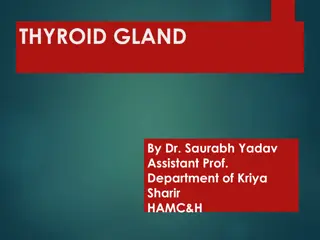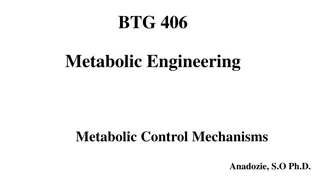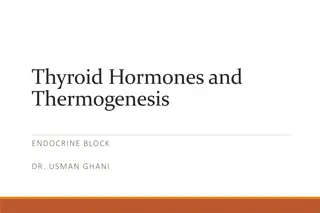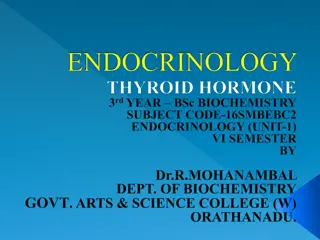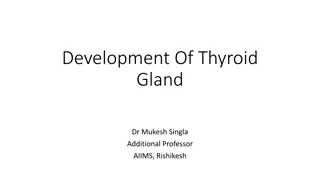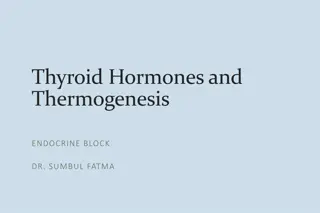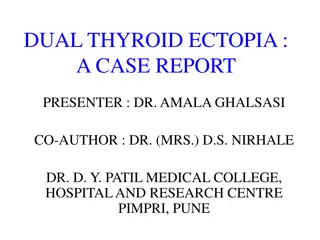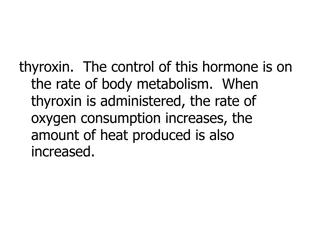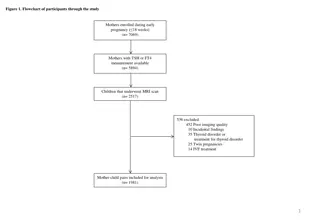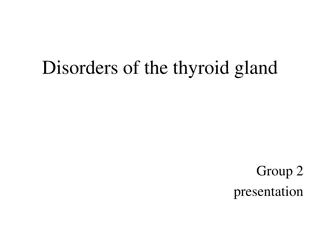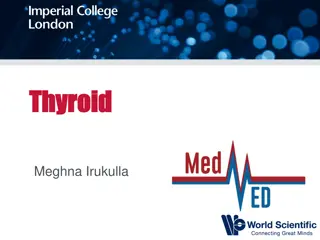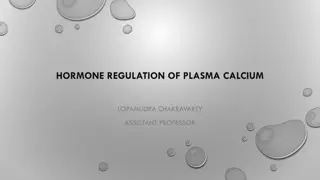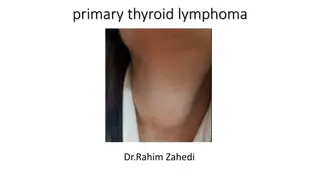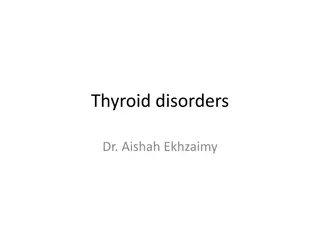Thyroid Hormone Biosynthesis and Metabolic Pathways
The secretion of thyroxine (T4) and triiodothyronine (T3) plays a critical role in regulating the activity of the thyroid hormonal axis. Various metabolic pathways influence the plasma concentration and cellular uptake of thyroid hormones, ultimately impacting their actions on peripheral tissues. The formation of biopotent analogues, conjugates, and deiodinated forms of T4 and T3 further modulates thyroid hormone activity. Understanding these intricate processes sheds light on the complex mechanisms underlying thyroid function and metabolic regulation.
Download Presentation

Please find below an Image/Link to download the presentation.
The content on the website is provided AS IS for your information and personal use only. It may not be sold, licensed, or shared on other websites without obtaining consent from the author.If you encounter any issues during the download, it is possible that the publisher has removed the file from their server.
You are allowed to download the files provided on this website for personal or commercial use, subject to the condition that they are used lawfully. All files are the property of their respective owners.
The content on the website is provided AS IS for your information and personal use only. It may not be sold, licensed, or shared on other websites without obtaining consent from the author.
E N D
Presentation Transcript
P.G. BIOSYNTHETIC ASPECTS OF THYROID HORMONE VBC-612 UNIT-1 26.11.2020
THYROID HORMONE Secretion of thyroxine (T4) and triiodothyronine (T3) from the thyroid gland provides an overall set-point for the activity of thyroid hormonal axis The hormone from adrenal cortex and gonads, influence the thyroid hormone plasma concentration by governing the cellular uptake and metabolism of thyroid hormones The prereceptor processes is critical determinants of the cellular level of T3 available for binding tonuclear thyroid hormone receptors The metabolic fate of thyroid hormones in peripheral tissues serves an important control mechanism of thyroid hormone action
INTRACELLULAR METABOLIC ALTERATIONS OF T4 IN PERIPHERAL TISSUES
Triac- an Acetic acid analogue formed by decarboxylation and deamination of T3 Have greater intrinsic biopotency because of their increased affinity for thyroid hormone receptors Reverse T3 (rT3) formed by 5-deiodination of T4 Sulfated and glucuronidated forms of T4 and T3 formed by conjugation of the phenolic ring hydroxyl group Progressive deiodination of T4, T3, and rT3 results in the formation of various diiodinated and monoiodinated thyronines- generally believed to have little or no biologicactivity 3,5-T2 has been demonstrated to enhance mitochondrial respiratory function, favorably impact circulating lipid levels, liver metabolism, and insulin resistance in response to a high-fat diet or LDL receptor deficiency and have a protective effect on the development of diabetic nephropathy
the circulating monoiodinated compound 3-iodothyronamine (T1AM) produces bradycardia, dramatic decreases in body temperature and metabolic rate, and improved memory some of opposite effects to that expected of a classic thyroid hormone, are believed to result from nongenomic mechanisms via the G-protein coupled trace amine associated receptors or other high-affinity molecular targets Tetrac and Triac are much better substrates for glucuronidation than are T4 and T3 The acetic acid analogues and sulfated conjugates are also markedly better substrates for deiodination in the liver and kidney than are the native compounds
Approximately 80% of the daily disposal of T4 by deiodination at either the 5 or 5 position T3 and rT3, are present primarily in the intracellular compartment the form of acetic acid analogue in the urine is suggesting that deamination plays important role in thyroid hormone metabolism than is apparent from the very low circulating levels of Tetrac and Triac THYROID HORMONE KINETICS Consists hidden pools of thyroid hormone metabolites
The high affinity of T4 for plasmabinding proteins, along with its greater production rate, accounts for its relatively high concentration in serum, as well as its long serum half-life T3 and rT3 are present at much lower serum concentrations because of their lower production rates, greater metabolic clearance rates, and lower affinity for TBG The two triiodothyronines appear to reside primarily within the intracellular compartment, and thus their volumes of distribution are significantly greater than that of T4 The rate of T4 production remains remarkably constant
THYROID HORMONE PRODUCTION Three deiodinase isoforms, termed D1, D2, and D3, are present in vertebrate species differ in their catalytic properties, patterns of tissue expression, and mechanisms of regulation 5 deiodination reactions is considered as activating processes, And 5 deiodination reactions is considered as inactivating processes
The deiodinases all require the availability of a reduced thiol cofactor for efficient catalytic cycling to displace iodine from an enzyme intermediate formed during the reaction and thus to regenerate the active deiodinase D1 is sometimes referred to as a high Km enzyme D2 is said to catalyze a low Km 5 -deiodination process Inhibitors marked sensitivity of D1 to the antithyroid drug propylthiouracil (PTU) thioureylene drugs carbimazole and methimazole have no inhibitory effect on deiodination
DEIODINASE STRUCTURE a molecular mass of approximately 29 to 32 kD function as homodimers As integral membrane protein as they contain a hydrophobic region near the N terminus selenoproteins in that they contain the uncommon amino acid selenocysteine as the reactive residue in the catalytic cleft selenocysteine ionized at physiologic pH, thus serving as a much more potent nucleophile than cysteine During post translation a specific stem-loop structure in the 3 -untranslated region of the mRNA termed a selenocysteine insertion sequence directed its incorporation A unique tRNA, (Sec-tRNA[Sec]), a specific RNA binding protein, and a specialized elongation factor are also required for efficient synthesis of selenoproteins
DEIODINASE REGULATION regulated by multiple hormones, growth factors, and environmental and nutritional factors alterations in thyroid status induce profound changes in enzyme activity Hypothyroidism is associated with a marked decrease in D1 and D3 levels, whereas D2 activity increases several fold and Opposite changes occur in hyperthyroidism Hyperthyroidism results in rapid downregulation of D2 activity by ubiquitination of the D2 protein D2 mRNA is Decreased and D2 mRNA is decreased Catalysis-induced inactivation of D1- the 3 -untranslated region of the human D1 mRNA has been proposed as a target for the micro-RNA MiR-224
TSH and thyroid-stimulating immunoglobulins stimulate both D1 and D2 activity in brown adipose tissue, where cold exposure, bile acids, or intracerebroventricular administration of leptin markedly stimulate D2 activity in the liver, where nutritional deprivation, diabetes, tumor necrosis factor, and other cytokines decrease D1 activity


